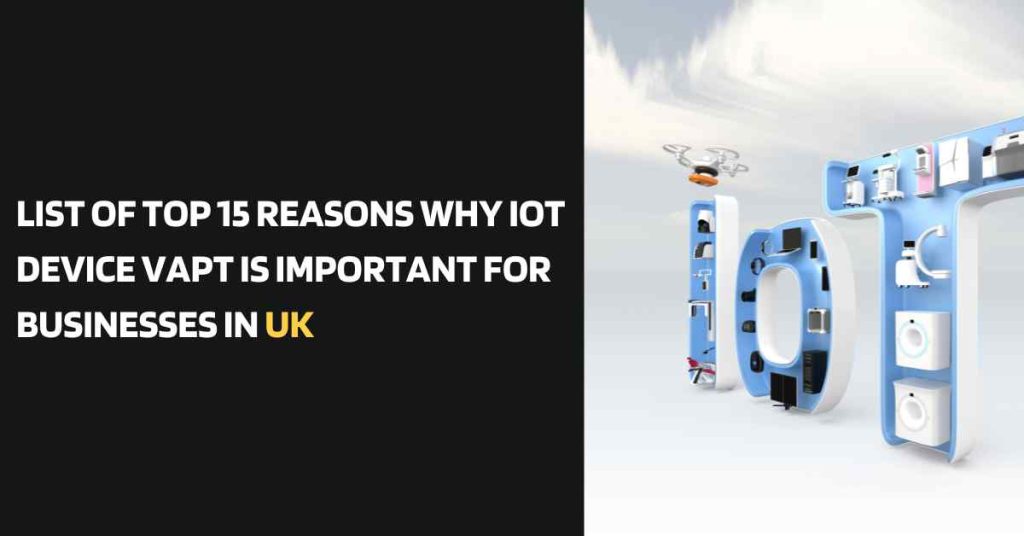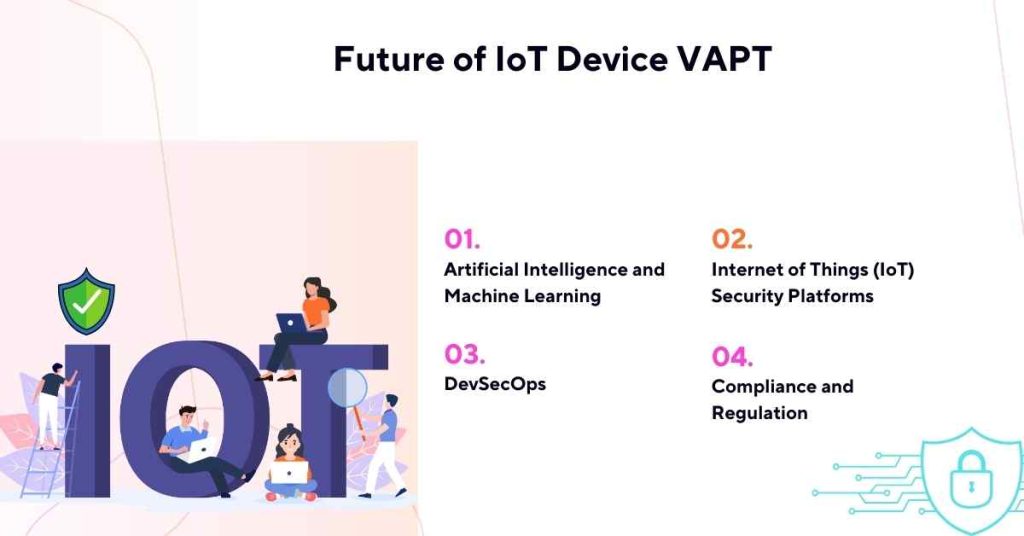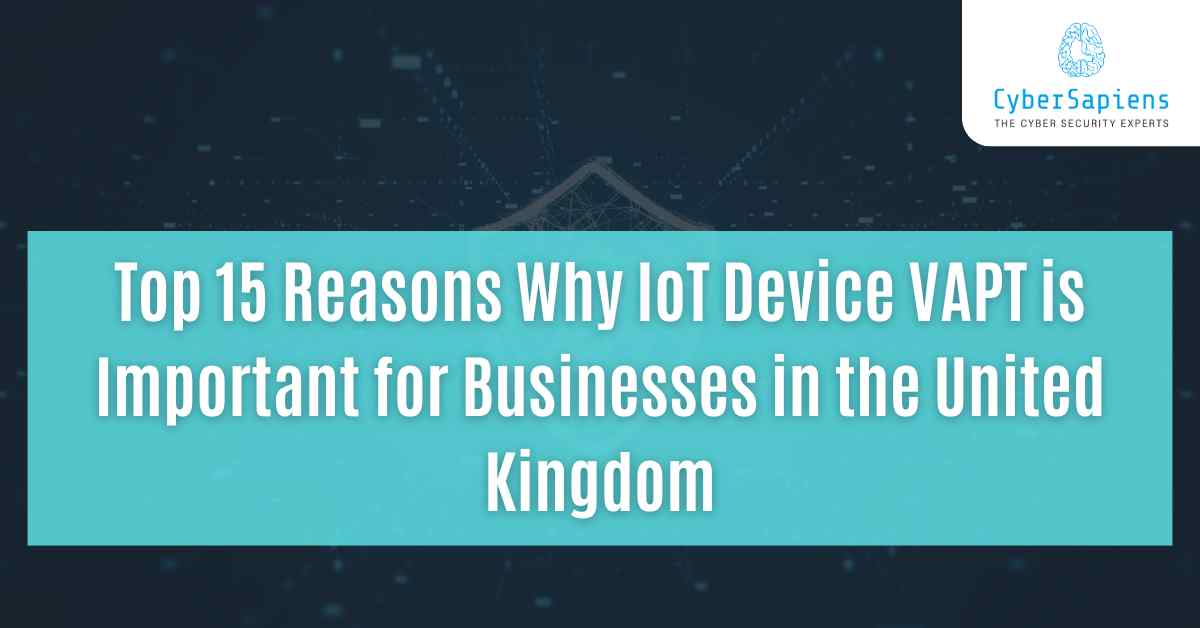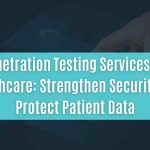The Internet of Things (IoT) has undoubtedly transformed the way businesses operate in the United Kingdom.
With the increasing adoption of smart devices, IoT has enabled organizations to streamline their operations, enhance customer experience, and boost productivity. However, the growing reliance on IoT devices has also introduced new security risks.
In this context, Vulnerability Assessment and Penetration Testing (VAPT) of IoT devices has become a critical necessity for businesses in the UK.
In this article, we will explore the top 15 reasons why IoT device VAPT is essential for businesses in the United Kingdom.
List of Top 15 Reasons Why IoT Device VAPT is Important for Businesses in the United Kingdom

Here is the list of the Top 15 Reasons Why IoT Device VAPT is Important for Businesses in the United Kingdom:
1. Protection Against Cyber-Attacks
The UK has experienced a massive ramp-up of cybersecurity threats against IoT devices in the recent past. Hackers are now exploiting the weaknesses an IoT device may have for stealing valuable information, manipulating businesses and even holding them ransom.
Since VAPT results reveal the actual weaknesses in the IoT devices used by businesses, it is easier to correct them before rover hackers take advantage of them.
2. Compliance with UK Regulations
Different regulations identified in the UK include the Product Security and Telecommunications Infrastructure Bill (PSTI) and the General Data Protection Regulation (GDPR).
Constant VAPT of IoT devices enables organizations to meet these regulations and escape hefty penalties.

3. Safeguarding Sensitive Data
IoT devices may act as data acquisition and processing nodes for the obtained information: PII and financial data.
The use of VAPT on IoT gadgets makes it possible to shield such data against access, theft or manipulation by unauthorized persons.
4. Preventing Downtime and Disruption
Through the consideration of several case studies the paper shows that cyber-attacks on IoT devices lead to extensive losses in man-hours and business disruption.
VAPT of IoT is valuable to periodically run to check for flaws that might make the devices halting and inefficient which businesses can avoid beforehand.
5. Maintaining Customer Trust
Companies in the UK depend heavily on customer trust to remain relevant.
Regular VAPT of IoT devices therefore helps businesses to show their customers that their security and data are important hence developing loyalty.
6. Reducing Financial Losses
This means that a hacker penetrating the IoT devices will lead to either direct or indirect monetary losses which include the cost of mitigation, working hours as well as damage to brand image.
The above financial losses can be prevented by performing routine VAPT of IoT devices.
7. Identifying and Fixing Weaknesses
VAPT of IoT devices helps businesses learn the flaws and risks that the devices possess so that they can act and rectify the problem.
This will minimize cyber-crisis and will increase the security of IoT devices.
8. Improving Incident Response
Ongoing VAPT of IoT devices is a crucial asset for business entities in the sense that they make appropriate preparations when facing cyber threats. Thus, by analysing threats and risks, companies can create efficient further actions against cybercrimes and their consequences.
9. Enhancing Supply Chain Security
Many of the IoT devices are integrated into a complex supply chain system. VAPT of IoT devices if done regularly will help to ensure that the whole supply chain is protected fully against vulnerabilities.
10. Reducing the Attack Surface
VAPT of IoT devices helps in mitigating the possible risks by detecting those, which enables the stopping of existing openings for hackers to penetrate and compromise the devices.
11. Ensuring Network Security
Many IoT devices are connected to the network, and if an IoT device has a hole, that hole is a hole in the network. The undertaking of VAPT on IoT devices periodically enhances the security of the network.
12. Protecting Against IoT-Specific Threats
Commercial IoT groceries are exposed to certain risks, like botnets and Mirai malicious software. Performing routine Vulnerability Assessment and Penetration Testing on IoT devices can prevent these threats since it reveals more open points.
13. Meeting Industry Standards
There are potential user needs for security for IoT devices in some areas in the UK, for instance, healthcare and the finance sector come with standard security requirements for IoT devices.
This is also achieved through the timeous VAPT of IoT devices to meet and even surpass such standards.
14. Improving Device Performance
VAPT of IoT devices can also discover current misconfigurations or otherwise suboptimal configurations that may affect the devices.
Solving these problems will help organizations to enhance device performance and increase the product’s longevity.
15. Future-Proofing IoT Devices
As IoT devices continue to evolve and become more sophisticated, new vulnerabilities and weaknesses may emerge.
Conducting regular VAPT of IoT devices helps businesses stay ahead of these new threats and ensures that their IoT devices are future-proof.
Future of IoT Device VAPT

As IoT devices continue to evolve and become more sophisticated, the need for VAPT will only increase. Here are some future trends and developments that will shape the future of IoT device VAPT:
1. Artificial Intelligence and Machine Learning
Predictably, AI and machine learning will have a significant role in IoT device VAPT, as businesses work to address the threats and risks more proactively.
2. Internet of Things (IoT) Security Platforms
Security solutions for the IoT are going to become popular as a vertical solution for IoT device monitoring and VAPT.
3. DevSecOps
There has been a trend towards the implementation of security into the IoT ecosystem, which will be further popularized by DevSecOps.
4. Compliance and Regulation
The compliance and regulation aspects will remain significant to IoT device VAPT as new compliance and regulatory measures hit the surface to overcome the impact of IoT cyber-attacks.
Summary
Here is the summary for the blog title ” Top 15 Reasons Why IoT Device VAPT is Important for Businesses in the United Kingdom ” :
- Protection Against Cyber-Attacks
- Compliance with UK Regulations
- Safeguarding Sensitive Data
- Preventing Downtime and Disruption
- Maintaining Customer Trust
- Reducing Financial Losses
- Identifying and Fixing Weaknesses
- Improving Incident Response
- Enhancing Supply Chain Security
- Reducing the Attack Surface
- Ensuring Network Security
- Protecting Against IoT-Specific Threats
- Meeting Industry Standards
- Improving Device Performance
- Future-Proofing IoT Devices
Conclusion
IoT device VAPT is critical for businesses in the United Kingdom, as it helps protect against cyber-attacks, ensures compliance with regulations, and safeguards sensitive data.
By conducting regular VAPT of IoT devices, businesses can identify and fix vulnerabilities, prevent downtime and disruption, maintain customer trust, and reduce financial losses.
In a rapidly evolving IoT landscape, regular VAPT of IoT devices is essential for staying ahead of emerging threats and ensuring the security and integrity of IoT devices.
FAQs: Top 15 Reasons Why IoT Device VAPT is Important for Businesses in the United Kingdom
1. What is IoT Device VAPT?
Ans: IoT device VAPT stands for Vulnerability Assessment and Penetration Testing. It is a process of identifying vulnerabilities and weaknesses in IoT devices and simulating real-world attacks to test the defences of the devices. VAPT helps businesses ensure the security and integrity of their IoT devices, protect against cyber-attacks, and maintain compliance with regulations.
2. Why is IoT Device VAPT important?
Ans: IoT device VAPT is important because it helps businesses identify and fix vulnerabilities and weaknesses in IoT devices, reducing the risk of cyber-attacks and data breaches. Regular VAPT also ensures that businesses meet the security standards and regulations required by their industry, helping to maintain customer trust and avoid financial losses.
3. What types of IoT devices require VAPT?
Ans: All IoT devices require VAPT, including smart thermostats, security cameras, wearables, home appliances, and industrial control systems. Any device that connects to the internet or a network is vulnerable to cyber-attacks and requires VAPT to ensure its security.
4. How often should I conduct IoT device VAPT?
Ans: The frequency of IoT device VAPT depends on the specific device and the level of risk it poses. As a general rule, it is recommended to conduct VAPT every 6-12 months, or whenever there are significant changes to the device or its configuration.
5. What is the difference between vulnerability assessment and penetration testing?
Ans: Vulnerability assessment is the process of identifying vulnerabilities and weaknesses in IoT devices, while penetration testing is the process of simulating real-world attacks to test the defenses of the devices. Both vulnerability assessment and penetration testing are essential components of VAPT.
6. Can I conduct IoT device VAPT myself?
Ans: While it is possible to conduct IoT device VAPT yourself, it is recommended to employ experienced security professionals who have the necessary expertise and knowledge to identify vulnerabilities and weaknesses in IoT devices. These professionals can provide a comprehensive and accurate assessment of the device’s security.
7. What are the benefits of outsourcing IoT device VAPT?
Ans: Outsourcing IoT device VAPT to a third-party provider offers several benefits, including expertise, scalability, and cost-effectiveness. Third-party providers have the necessary expertise and tools to conduct VAPT effectively, and can provide comprehensive and accurate results.
8. What are the common vulnerabilities found in IoT devices?
Ans: Common vulnerabilities found in IoT devices include buffer overflow, SQL injection, cross-site scripting (XSS), and man-in-the-middle (MITM) attacks. These vulnerabilities can be exploited by hackers to gain unauthorized access to the device or steal sensitive data.
9. How can I remediate vulnerabilities identified during VAPT?
Ans: Remediation involves addressing vulnerabilities and weaknesses identified during VAPT. This can be achieved through patching, updating, or reconfiguring the device, or replacing the device with a more secure alternative. It is essential to prioritize remediation based on the severity and likelihood of the vulnerability being exploited.
10. What are the standards and regulations for IoT device VAPT?
Ans: There are several standards and regulations for IoT device VAPT, including the Product Security and Telecommunications Infrastructure Bill (PSTI) and the General Data Protection Regulation (GDPR) in the UK. These standards and regulations require businesses to ensure the security of their IoT devices and protect sensitive data from unauthorized access or theft.












